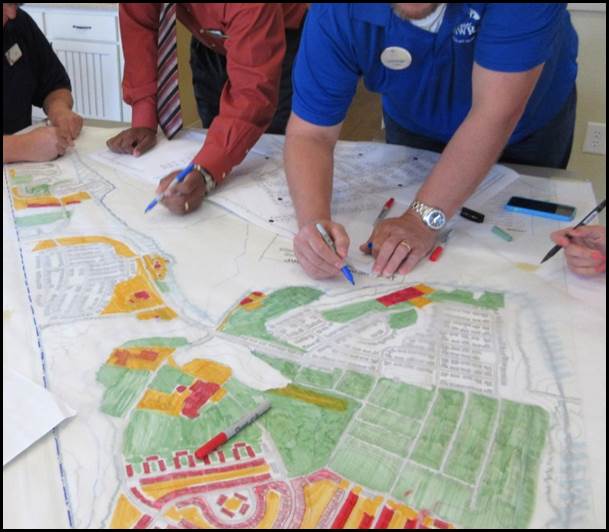Komal Dewan
On Edge is a series about stress in 2017.
Maybe you think your job is stressful. And hey, it very well might be. Maybe your boss is a moron, or you’re juggling multiple projects, or you have to get along with a coworker who insists on saying shit like, “Sounds like somebody’s got a case of the Mondays.”Still, it likely pales compared to the magnitude of serving in the armed forces. Imagine, for example, you’re part of a young family that’s been shipped off to a base in rural Oklahoma—no friends, no extended family—and that’s before your spouse gets deployed to Iraq for six months.“It’s very stressful, from a mental health perspective, especially,” says University of Oregon professor Mark Gillem, director of the school’s Urban Design Lab. And it’s part of the reason why the architects and urban planners who design military bases have, in recent years, begun placing a renewed emphasis on creating facilities that can support and enhance the mental wellbeing of soldiers and their families.Gillem explains that for many years, military bases mirrored surrounding suburban sprawl: low-density, automobile-oriented, not conducive to walking or biking. And Gillem, who was in active duty in the US Air Force for nine years and spent another 12 in the Reserves, saw firsthand the problems with this kind of poor planning: the costs associated with it, the inefficiencies of it, the burden on physical and mental health—and ultimately, the damage to the longevity of the mission.Today, he’s the principal of the Urban Collaborative, an urban design firm where he applies that experience to determine what we can do differently. “A military base is like a city. You have hospitals and parks and housing and offices, shopping centers and restaurants,” Gillem explains. “We have the ingredients to make great places, it’s just the the recipe we’ve been using has been inadequate.”He points to an idea called neighborhood cohesion—a sociological concept pioneered at the University of Chicago that’s something of a proxy for a sense of community. “When there’s a stronger sense of community or stronger neighborhood cohesion, communities will be more resilient,” he explains, adding that higher levels of neighborhood cohesion correlate with lower rates of domestic violence, lower rates of drug abuse, and lower rates of child abuse. “And the reason why is: People are better able to take care of one another.”So how do you improve that cohesion? Gillem says it comes down to two things: the built environment and the types of housing. The military’s land-use plans, for a long time, put housing in one area, shopping and commercial buildings in another, and socially-oriented spaces in another. But what you actually want is to have neighborhoods with a mix of those uses within walking distance. These, he says, have much higher rates of neighborhood cohesion.In terms of the kind of housing, he notes that—somewhat counterintuitively—super-dense condo towers can actually be more isolating than a single-family building or townhome. People tend to get home, go in, and shut off, whereas single-family homes and townhomes encourage families to sit on their stoops, engaging with the people who walk by.But that might not tell the whole story.“There’s schools of thought that say those community condo-type buildings don’t work, but the reason for that is because there’s really no place to gather,” adds Komal Dewan, vice president and director of planning and federal programs for AECOM, where she specializes in Department of Defense installations. “There’s actually a renewed emphasis on connectivity, and on using outdoor spaces, where possible, to connect people.” That means pocket parks and barbecue pits for adults, swimming pools and play places for kids. Planners have come to see these things as more than just amenities, instead acknowledging that they serve a crucial function when it comes to bringing military families together and breaking down feelings of isolation.Dewan also points to the concept of “healing gardens,” restorative green spaces that are becoming popular in Midwestern hospitals. Here, the idea is that when someone is being treated for a physical or mental ailment, there’s only so much you can do inside the building. “There’s a whole emphasis on creating the spaces that are outside facilities, those interstitial spaces between facilities that allow people to heal.” Today, there’s a specialty of landscape architecture that’s in creating areas of repose—a whole environment of sights, sounds, smells, a sensory experience that goes hand in hand with the medically therapeutic side of care.“If you’re in Afghanistan or you’re in Iraq, you’re in a very jangling atmosphere where all your senses have been shaken. Those are the people that are most impacted by loud noises, sudden movement,” she says. “The idea is, how do you create areas of calm that—while they’re not going to cure them—will enable medical options to succeed better?”And in addition to these designated spaces—be they healing gardens or BBQ pits—as important as the kinds of structures on a base (and perhaps moreso) is having at least a few of these things within walking distance of your home.Dewan explains that increasingly, bases are focusing on the way they build connecting spaces—sidewalks, jogging paths, bike routes—that get people out of their cars and interacting with one-another on a physical level. This type of incidental contact, she explains, creates “an unforced sense of community.”“You see people on the paths that you’re running on,” Dewan, who has a background in architecture and urban planning, notes. “You wave to somebody as you walk a child by them, as opposed to people driving in their cars, isolated from everybody else.”You need to be thoughtful in designing these spaces, too. For example, a walking path should be wide enough to accomodate someone pushing a stroller while allowing someone walking a dog to pass, to smile—and maybe, to begin seeing each other regularly, eventually forging a friendship. “Creating those kinds of spaces that allow people to mingle has become huge,” she says.Recent studies have shown that civilians prefer walkable, mixed-use communities; one 2015 survey found that being within walking distance of parks, shops, and other amenities was important to eight out of ten people. And developers are taking note. Master-planned communities like the new Walsh development in Fort Worth, Texas, are plugging in walking trails rather than building golf courses; Manhattan’s new Via 57 West has a 22,000-square-foot courtyard with 47 native plants and barbecue grills meant to “nourish your mind, body, and soul.”As we shift from a culture of sprawl toward one where we use spaces more thoughtfully, Gillem says these theories can be applied from East Coast cities to Silicon Valley office complexes. “Whether you’re planning an IBM campus or an Apple campus or a military base, it’s just following a solid planning process,” he adds.Read this next: Colleges Need to Do More to Support Students With Cancer
That means pocket parks and barbecue pits for adults, swimming pools and play places for kids. Planners have come to see these things as more than just amenities, instead acknowledging that they serve a crucial function when it comes to bringing military families together and breaking down feelings of isolation.Dewan also points to the concept of “healing gardens,” restorative green spaces that are becoming popular in Midwestern hospitals. Here, the idea is that when someone is being treated for a physical or mental ailment, there’s only so much you can do inside the building. “There’s a whole emphasis on creating the spaces that are outside facilities, those interstitial spaces between facilities that allow people to heal.” Today, there’s a specialty of landscape architecture that’s in creating areas of repose—a whole environment of sights, sounds, smells, a sensory experience that goes hand in hand with the medically therapeutic side of care.“If you’re in Afghanistan or you’re in Iraq, you’re in a very jangling atmosphere where all your senses have been shaken. Those are the people that are most impacted by loud noises, sudden movement,” she says. “The idea is, how do you create areas of calm that—while they’re not going to cure them—will enable medical options to succeed better?”And in addition to these designated spaces—be they healing gardens or BBQ pits—as important as the kinds of structures on a base (and perhaps moreso) is having at least a few of these things within walking distance of your home.Dewan explains that increasingly, bases are focusing on the way they build connecting spaces—sidewalks, jogging paths, bike routes—that get people out of their cars and interacting with one-another on a physical level. This type of incidental contact, she explains, creates “an unforced sense of community.”“You see people on the paths that you’re running on,” Dewan, who has a background in architecture and urban planning, notes. “You wave to somebody as you walk a child by them, as opposed to people driving in their cars, isolated from everybody else.”You need to be thoughtful in designing these spaces, too. For example, a walking path should be wide enough to accomodate someone pushing a stroller while allowing someone walking a dog to pass, to smile—and maybe, to begin seeing each other regularly, eventually forging a friendship. “Creating those kinds of spaces that allow people to mingle has become huge,” she says.Recent studies have shown that civilians prefer walkable, mixed-use communities; one 2015 survey found that being within walking distance of parks, shops, and other amenities was important to eight out of ten people. And developers are taking note. Master-planned communities like the new Walsh development in Fort Worth, Texas, are plugging in walking trails rather than building golf courses; Manhattan’s new Via 57 West has a 22,000-square-foot courtyard with 47 native plants and barbecue grills meant to “nourish your mind, body, and soul.”As we shift from a culture of sprawl toward one where we use spaces more thoughtfully, Gillem says these theories can be applied from East Coast cities to Silicon Valley office complexes. “Whether you’re planning an IBM campus or an Apple campus or a military base, it’s just following a solid planning process,” he adds.Read this next: Colleges Need to Do More to Support Students With Cancer
Advertisement
Advertisement

Advertisement
Advertisement
